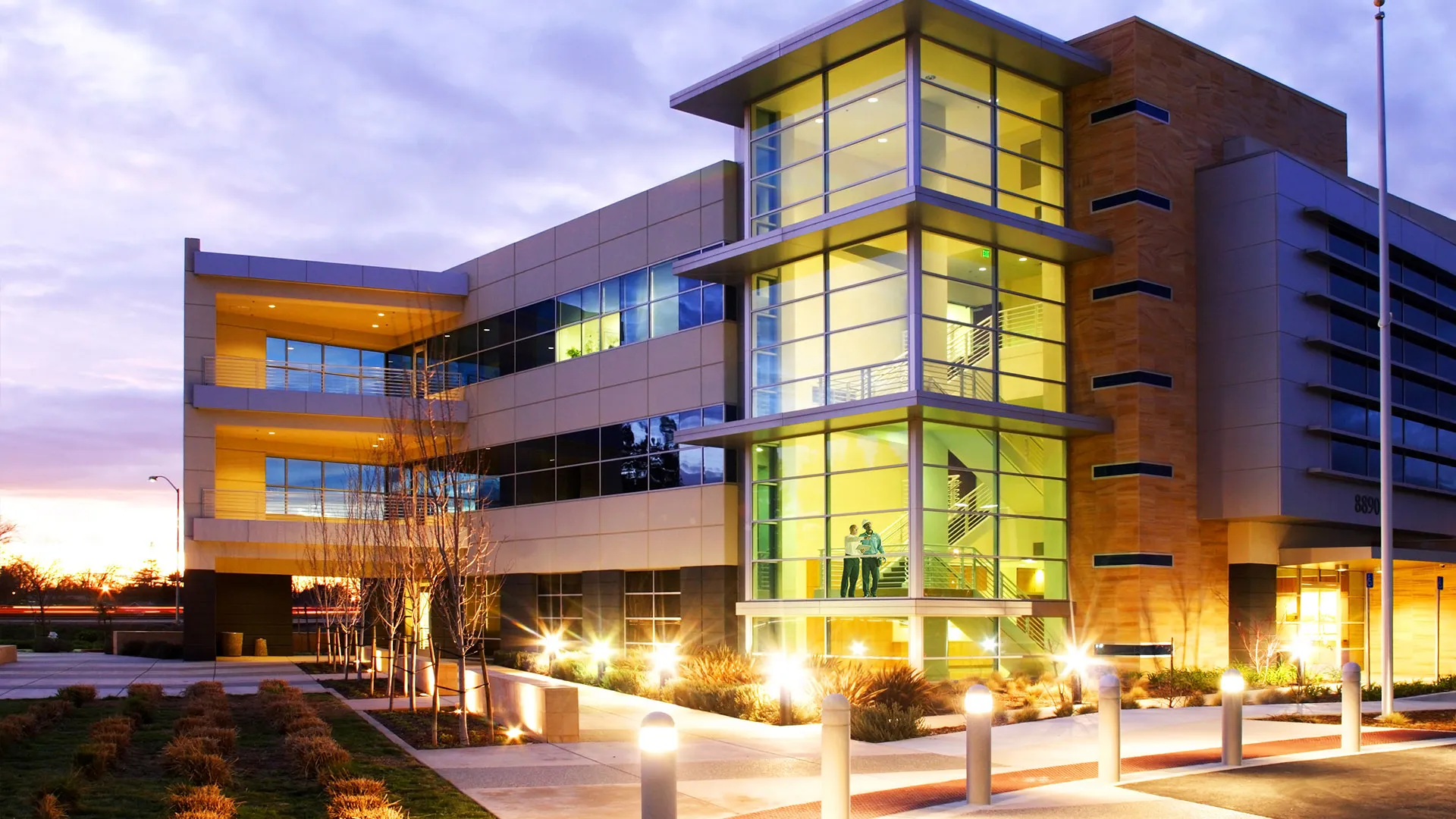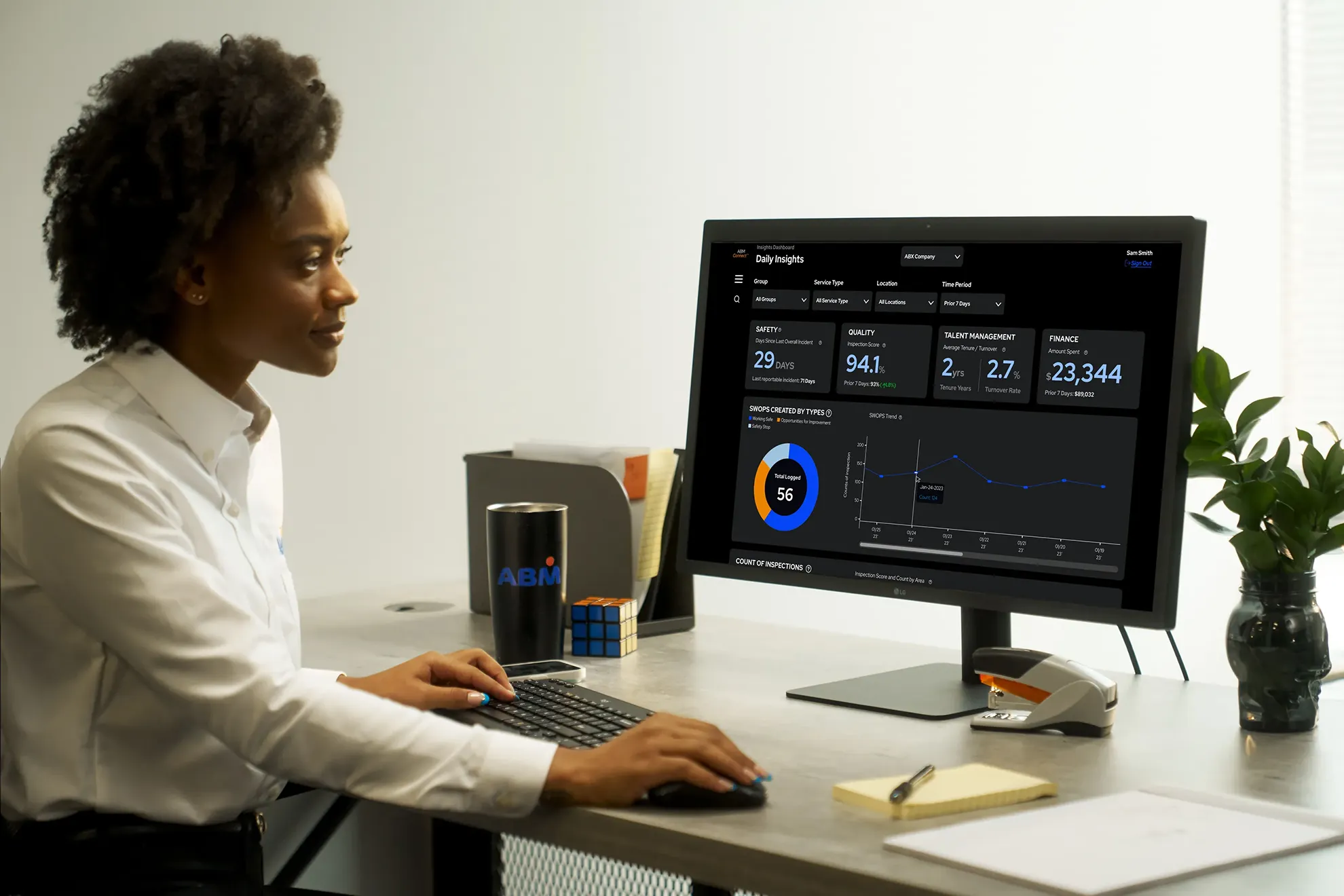Why Open Offices Need a Specialized Approach
SPECIAL CONSIDERATIONS FOR OPEN OFFICES
How Thoughtful Facility Management Can Help Technology Companies Drive Innovation
INTRODUCTION
Most technology companies opt for open office spaces over more traditional models, like cubicles or private offices. Open offices help companies maximize the utility of every square foot, foster better workplace collaboration, and create a more engaging work environment. However, open office spaces also pose a special set of challenges. Germs spread more easily, leading to increased sick days.
Temperature fluctuations can become a sticking point and lead to unhappy employees. Additionally, employing the right cleaning methodology can make the difference between a clean, comfortable office and dirty, dysfunctional spaces. Read on and learn more about how to master these challenges from the experts at ABM.
PART I. SOOTHE THE SIDE EFFECTS OF OPEN OFFICES
Let’s start with a positive. Despite worries over distraction and lack of privacy, open offices are reducing stress and providing a unique health benefit. A 2018 study, part of the US General Services Administration’s Well built for Wellbeing research, found workers in an open office more physically active, and linked that physical activity to 14%less physiological stress outside the office.
So, open offices are helping employees get out of their chairs and move around more. That’s a plus for employee wellness, but it’s not why cubicles got their walking papers. Fostering cross-functional collaboration and improving creativity are important considerations for businesses that live and die by creating then ext big thing. An office culture that attracts and engages talent is now a necessity.
But the side effects of an open office are chipping away at those claims. Noise, distraction, and lack of privacy can discourage face-to-face collaboration, and the increased workplace density can encourage the wrong kind of sharing – namely germs. Research indicates employees in open offices are twice as likely to get sick.
To keep open-office collaboration fostering innovation, the unique challenges of cleanliness, hygiene, and good air quality for open offices must be met. New research shows that place identity, or how an employee feels about their space, leads employees to experience open offices differently.
Accounting for Workspace DensityLet’s be honest, one key benefit of open offices is that increased workspace density can also save on office space. Sharing desks, or hot desking, and other design strategies create space efficiency, but that efficiency means fewer barriers for germs, and more touches per touch point. Traditional standard operating procedures for office cleaning, often based on square footage, won’t keep up with the effects of increased traffic.
Cleaning programs for open offices should move to a model that accurately captures how much cleaning is required. Focusing on work space count and use may increase costs as measured by a traditional square-foot model, but choosing savings over addressing essential needs will incur more employee sick time. Reducing cleaning frequency to compensate is also tempting, but shared desks may require more frequency, not less, to keep standards high.
More employees on a floor or section also increase restroom traffic and the use of shared spaces nearby. Restrooms will need restocking more frequently, especially to encourage proper hand washing and retain a hygienic image.
Shared spaces meant to invite spontaneous collaboration need to look inviting. In order to stay cost-effective, cleaning programs for open offices should look to ensure efficiency.Cleaning staff should be trained in methodical processes that reduce the number of motions needed, with proper equipment that empowers best practices. For example, the right wiping patterns cut excess motion and reduce cloth use, while an extension wand helps clean a baseboard without forcing a janitor to stoop or bend over.
Support Everyone’s Hygiene Efforts
Hygiene is key to a good cleaning program, even more so for open offices. Hand sanitizer should be accessible wherever employees share equipment — like conference rooms, lobby areas, and break rooms — any shared space without access to soap and water. Remind teams of the importance of hand hygiene with your internal communications, but ensure the space also communicates that message by keeping hygiene resources available.
In open offices, collaboration can turn almost any space into a shared space, but small team sand individuals may need privacy for calls or closed-door discussions. Many companies create informal “specialty collaborative” spaces with brainstorming rooms, video conferencing rooms, or project spaces. Whatever is on the label, these spaces are full of equipment and surfaces. A cleaning program needs to account for these informal spaces with proper hygiene products. Special care should be taken to identify unlabeled locations that nevertheless see heavy use.
Increased attention to touch points will also improve hand hygiene overall and prevent the spread of viruses and bacteria. Combine microfiber cloths and disinfectants to effectively remove viruses and kill bacteria.Open office cleaning programs should widen their scope of touch points. It’s common to list door handles and countertops, but humans tend to touch everything — the backs of chairs, white boards, and even coffee machines need to be disinfected, especially with the increased traffic of an open office.
Improving Indoor Air Quality Is More Important than Ever
Employee health and indoor air quality(IAQ) have long been linked, but a recent Harvard study proves the impact of improved ventilation on creativity and cognitive processes. One best practice for improvedIAQ is keeping particulates from entering your building. Properly installed entryway mats keep contaminants from entering your workspace.That enhances efficiency, reducing the work needed elsewhere to remove those particles out of the air. Green cleaning can also keep a building’s air cleaner, but special attention should be paid to the chemical content.
Equipment also factors into indoor air quality. Vacuums and extractors should be certified to ensure air quality. To receive the Carpet andRug Institute Seal of Approval, vacuums are rigorously tested and required to not release more than 100 micrograms of dust particles per cubic meter of air. Carpet extractors must remove most of the moisture left from the cleaning process to reduce the risk of mold and mildew.
Heating and cooling systems play a key role protecting indoor air quality.
Preventive HVAC maintenance is a must for open offices, keeping particle control and ventilation reliable.
To ensure HVAC maintenance plays its part, consider these questions:
• Are HVAC systems inspected regularly?
• Are reservoirs and ductwork checked for microbial contaminants?
• Are air filters placed correctly?
Improperly seated air filters reduce efficiency and indoor air quality. According to the Center for Disease Control, poor maintenance of HVAC systems is one of the most common causes of poor indoor air quality. A preventative program stays ahead of these issues. To encourage transparency, HVAC programs should provide clear records of inspections and maintenance.
Stay Open to the Big Picture
An open office plan puts the results of facility operations on display, with large, open spaces always visible to the eye. That constancy puts cleaning programs and facility maintenance under a microscope, but it’s also a great opportunity. “Place identity” can meaning fully change how employees react to open offices.Researchers note that place identity can make the difference between an open office feeling flexible and energetic, or coming across ascluttered and noisy.When employees are given a clear vision of how an open office benefits them, they’re more satisfied. Protect the promise of your open office design with effective and efficient cleaning, hygiene, and air quality operations.Let’s start with a positive. Despite worries over distraction and lack of privacy, open offices are reducing stress and providing a unique health benefit. A 2018 study, part of the USGeneral Services Administration’s Wellbuilt forWellbeing research, found workers in an open office more physically active, and linked that physical activity to 14% less physiological stress outside the office.
So, open offices are helping employees get out of their chairs and move around more. That’s a plus for employee wellness, but it’s not why cubicles got their walking papers. Fostering cross-functional collaboration and improving creativity are important considerations for businesses that live and die by creating the next big thing. An office culture that attracts and engages talent is now a necessity.
But the side effects of an open office are chipping away at those claims. Noise, distraction, and lack of privacy can discourage face-to-face collaboration, and the increased workplace density can encourage the wrong kind of sharing – namely germs. Research indicates employees in open offices are twice as likely to get sick.To keep open-office collaboration fostering innovation, the unique challenges of cleanliness, hygiene, and good air quality for open offices must be met. New research shows that place identity, or how an employee feels about their space, leads employees to experience open offices differently.
Accounting for Workspace Density
Let’s be honest, one key benefit of open offices is that increased workspace density can also save on office space. Sharing desks, or hot desking, and other design strategies create space efficiency, but that efficiency means fewer barriers for germs, and more touches per touch point. Traditional standard operating procedures for office cleaning, often based on square footage, won’t keep up with the effects of increased traffic.
Cleaning programs for open offices should move to a model that accurately captures how much cleaning is required. Focusing on workspace count and use may increase costs as measured by a traditional square-foot model, but choosing savings over addressing essential needs will incur more employee sick time. Reducing cleaning frequency to compensate is also tempting, but shared desks may require more frequency, not less, to keep standards high.
More employees on a floor or section also increase restroom traffic and the use of shared spaces nearby. Restrooms will need restocking more frequently, especially to encourage proper hand washing and retain a hygienic image.
Shared spaces meant to invite spontaneous collaboration need to look inviting. In order to stay cost-effective, cleaning programs for open offices should look to ensure efficiency. Cleaning staff should be trained in methodical processes that reduce the number of motions needed, with proper equipment that empowers best practices. For example, the right wiping patterns cut excess motion and reduce cloth use, while an extension wand helps clean a baseboard without forcing a janitor to stoop or bend over.
Support Everyone’s Hygiene Efforts
Hygiene is key to a good cleaning program, even more so for open offices. Hand sanitizer should be accessible wherever employees share equipment — like conference rooms, lobby areas, and break rooms — any shared space without access to soap and water. Remind teams of the importance of hand hygiene withy our internal communications, but ensure the space also communicates that message by keeping hygiene resources available.
In open offices, collaboration can turn almost any space into a shared space, but small team sand individuals may need privacy for calls or closed-door discussions. Many companies create informal “specialty collaborative” spaces with brainstorming rooms, videoconferencing rooms, or project spaces. Whatever is on the label, these spaces are full of equipment and surfaces. A cleaning program needs to account for these informal spaces with proper hygiene products. Special care should be taken to identify unlabeled locations that nevertheless see heavy use.
Increased attention to touch points will also improve hand hygiene overall and prevent the spread of viruses and bacteria. Combine microfiber cloths and disinfectants to effectively remove viruses and kill bacteria.Open office cleaning programs should widen their scope of touch points. It’s common to list door handles and countertops, but human stend to touch everything — the backs of chairs, white boards, and even coffee machines need to be disinfected, especially with the increased traffic of an open office.
PART II.3 WAYS TO REDUCE SICKNESS IN OPEN OFFICE ENVIRONMENTS
As open office plans increase in popularity, it’s become evident that they present a unique set of challenges. Studies have shown that employees are twice as likely to get sick in open working spaces. Absenteeism causes employers to lose $225.8 billion a year due to lost productivity. These costs undermine the cost-effectiveness of open office layouts. To avoid these pitfalls, companies need to adjust their cleaning programs to be more effective inreducing the spread of germs.
Help Occupants Maintain Hand Hygiene
It’s well-known that handwashing is the single most effective way to prevent the spread of infection. Hand hygiene is a critical component of any cleaning program, and the need for accessible, effective hygiene products is magnified in open offices where there’s more interaction amongst employees.
In addition to keeping soap stocked in restrooms, handwashing education makes a difference. Posters remind employees of the importance of proper hand hygiene and educate them on the most effective ways to clean their hands. According to the BradleyHealthy Handwashing Survey, nearly 40% ofAmericans say they’re more likely to wash their hands after seeing a sign that requires employees to wash before returning to work.
Outside the restroom, hand sanitizer should be located in high-traffic common areas, like lobbies, break rooms, and conference rooms. Ina recent study, hand sanitizing stations, bottles, and wipes were distributed in highly populated offices. The study found that there was a 13percent decrease in unscheduled time off.
Prepare for Increased Workspace Density
Along with the open office trend, the number of workspaces per square foot has increased. From 1970 to 2015, the average square footage per employee shrunk from 400 to 180 square feet. Housekeeping programs that are planned around square footage may not accurately capture how much cleaning is required.Instead, it’s important to focus on the number of workspaces that need to be cleaned. This may be more costly than the traditional price-per-square-foot model, but that can be addressed by driving increases in efficiency.By implementing equipment and processes that save time, cleaners can work more quickly without sacrificing occupant health.
Take Care of Touch Points
Many cleaning programs include touch point cleaning, but too often, it’s an afterthought. Touch points can hold on to germs for longer periods of time than hands. According to the CDC, the flu virus can live on hard surfaces for up to 24 hours.
To get rid of germs, it takes more than simply wiping them down. Cleaning with a combination of microfiber cloths and disinfectants is the most effective way to kill and physically remove bacteria and viruses.
Another common mistake in touch point cleaning is failing to identify the range of touch points in a facility. When people think of touch points, they most commonly think of doorhandles, elevator buttons, and countertops. But offices contain many more touch points – liket he backs of chairs, white boards, printers, and coffee machines. Including these in the cleaning scope of work ensures they won’t be neglected.
Open office floor plans magnify the importance of an attentive, expert facility maintenance program. By making considerations for the spread of germs, you can enjoy the savings and improved worker collaboration that the open office environment provides. These simple techniques enhance the occupant experience and reduce the high costs of employee illness.
PART III.WHY OFFICE CLIMATE ISA HOT BUTTON ISSUE
Studies by Gallup and others routinely find that high employee engagement leads to impressive business outcomes. Facing the growing mountain of analytics on the employee experience and reading through all the latest strategies for tempting top talent, heating and cooling operations might feel like they don’t make the cut.
But the hard data shows that temperature really affects employee productivity. Let’s look at some of the ways temperature is fundamental to the workplace experience, and how that transforms what looks like a facility management issue into a clear driver of engagement, productivity, and profitability
Why We Should Stop Calling It Comfort
Because it’s not about comfort – it’s about how our minds and bodies function. Let’s start with the direct effects of temperature. In a2004 study, Cornell University researchers investigated how the set temperature of an office affected worker output. When they compared the data for a 68-degree office and a77-degree one, the employees made 44% more errors when it was cooler. It also halved their productivity.
When we talk about office temperature as a comfort issue, it sounds like a nice-to-have, a bonus that’s easy to put off when budgets need crunching. But the facts are clear. When employees are too cold, they’re physically distracted. Energy goes to regulating body temperature, instead of performance.
Too much heat also drags down productivity. A study of Boston students found a group without air conditioning scored 13% worse on arithmetic tests.The study found that working in 80-degree temperatures impacted attention, processing speed, cognitive speed, and memory. Note that these students suffered those deficits only three degrees away from the preferred temperature of the Cornell study.
Employees also notice these effects themselves. In a 2015 survey, 53% agreed they are less productive when the office is too cold.Too warm rated even worse, with 71% agreeing that they are less productive when it’s too hot.
From Hard Data to Harder Truths
We know that temperature directly, physically affects our performance, but employee awareness of that problem leads to another level of issues. Employees know the temperature impacts their productivity, and that can lead to disengagement. Employees feel they can’t do their best work, causing anxiety over performance and increasing frustration that they have no recourse to fix the problem. In fact, respondents in one study of workplace environments ranked the inability to control temperature as the worst of several workplace complaints – worse than workplace privacy issues, poor lighting, and noise levels.
That frustration boils over into bigger problems: a 2018 poll found 15% of respondents admitted to having in-office arguments over temperature, and 19% admitted to secretly changing it without permission. Compare a UK survey from2017 where 32% admitted to regular arguments about the temperature. The same study where temperature control ranked the “worst”complaint also reported a remarkable correlation between workplace dissatisfaction and disengagement. While 80% of employees highly satisfied with their workplace environment said they generally liked their jobs, only 33% of employees less satisfied with the workplace said the same.
Even more striking are the productivity effects: the less satisfied group was half as likely to say they always help colleagues with work-related problems. They were two-thirds less likely to say they always offer ideas to improve the organization.
These results show there’s a disengagement feedback loop when it comes to office temperatures. On top of the adverse effects that temperatures can have on performance, employees soon become aware of those effects, leading to frustration with their working environment, wasting more energy and productivity.
Is There an Ideal Temperature Setting?
While reviews have compared studies and methods to find an ideally productive office temperature, those results are general. One well-regarded review from Berkeley Labsin 2006 located ideal performance at 71.6degrees Fahrenheit. But consider that men and women can have preferred temperatures almost five degrees apart. And that Cornell study cited earlier? Productivity was better at77 degrees Fahrenheit.If 77 °F seems too warm to you, consider what warmth means to us psychologically and socially, and how that translates directly into productivity. Experiments show that a warmer environment promotes clearer, more concrete use of language and a more positive perception of social relationships.
How employees think about their experiences also matters. Beliefs abound that colder temperatures help you stay active or alert, while warmer environments boost creativity or reduce stress. As tempting as the idea of an ideal temperature is, it’s still an ideal, and your employee productivity is as real world as it gets – every facility and every team is different. The Berkeley Labs review does compare multiple studies using concrete metrics for productivity, so 71.6 °F is a great starting point, but it’s not the last word. Since the performance and engagement data shows how much temperature affects employees, it’s clear that management should take employee concerns seriously and develop a strategy that helps reduce negative impacts and encourage positive ones.Facility managers can help team leaders respond to feedback faster or enable more discrete control of spaces for individuals and teams with newer control technologies.Depending on the facility, expert airflow assessments can open up solutions that not only address temperature, but other issues that impact productivity.
Tools That Attract and Retain Talent
Productivity isn’t the only way temperature affects engagement. Surveys report that70% of employees say sustainability affects whether they’ll stay with a company over the long term. Nearly 40% of millennials report taking a job over another because of sustainability. With heating and cooling playing a significant role in energy spend,HVAC systems play a large part in a facility’s sustainability. A smaller carbon footprint, LEED certification, and other sustainability goals demand efficient heating and cooling, and studies show meeting those goals matters to employees more than ever.The 2018 millennial survey from Deloitte shows that climate now ties with terrorism as the top concern of young workers in developed markets, beating out income inequality and unemployment.That’s a big change from the 2017 report, where climate rank.
From Comfort to Critical Need
From productivity to sustainability, temperature in the work environment deserves a top spot in any employee engagement strategy. Facility managers can present solutions for improved employee attraction, engagement, and retention with improvements to temperature control, maintenance, and energy efficiency. Looking at temperature control holistically, even more productivity comes into play.A recent Harvard study found that improved ventilation and reduced volatile organic compounds led to 101 percent higher cognitive scores. Proactive maintenance programs not only extend HVAC asset life – a boon to any facility budget – they also reduce the risk of equipment failures that can saddle employees with stifling or frigid workspaces.
Temperature and how we control it impacts workplace performance, employee satisfaction, sustainability issues, and of course, energy and operational costs. That makes the intersection of facility management and employee engagement into an opportunity for transformation and growth.
To help you assess possibilities and strategies for your business, look for a facility services partner well-versed in all the ways your HVAC contributes to your work environment.Comfort is good, but engaging, productive, and profitable is better.
CONCLUSION
A facility services partner with expertise in caring for open office environments helps you cost-effectively ensure that the innovative space you’ve invested in helps you drive innovation for your business.









